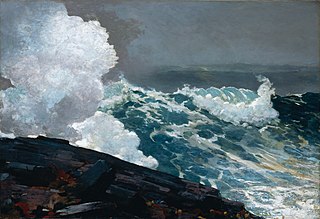
USS Massachusetts was an Indiana-class, pre-dreadnought battleship and the second United States Navy ship comparable to foreign battleships of its time. Authorized in 1890, and commissioned six years later, she was a small battleship, though with heavy armor and ordnance. The ship class also pioneered the use of an intermediate battery. She was designed for coastal defense and as a result, her decks were not safe from high waves on the open ocean.

Santiago de Cuba is the second-largest city in Cuba and the capital city of Santiago de Cuba Province. It lies in the southeastern area of the island, some 870 km (540 mi) southeast of the Cuban capital of Havana.

The Battle of Santiago de Cuba was a decisive naval engagement that occurred on July 3, 1898 between an American fleet, led by William T. Sampson and Winfield Scott Schley, against a Spanish fleet led by Pascual Cervera y Topete, which occurred during the Spanish–American War. The significantly more powerful US Navy squadron, consisting of four battleships and two armored cruisers, decisively defeated an outgunned squadron of the Royal Spanish Navy, consisting of four armored cruisers and two destroyers. All of the Spanish ships were sunk for no American loss. The crushing defeat sealed the American victory in the Cuban theater of the war, ensuring the independence of Cuba from Spanish rule.

Winslow Homer was an American landscape painter and illustrator, best known for his marine subjects. He is considered one of the foremost painters in 19th-century America and a preeminent figure in American art.

George Frederick Phillips, was a U.S. Navy Machinist First Class who received the Medal of Honor for his actions during the Spanish–American War in 1899.
Events from the year 1901 in art.

The Gulf Stream is an 1899 oil painting by Winslow Homer. It shows a man in a small dismasted rudderless fishing boat struggling against the waves of the sea, and was the artist's statement on a theme that had interested him for more than a decade. Homer vacationed often in Florida, Cuba, and the Caribbean.

Daniel Montague was a United States Navy sailor and a recipient of America's highest military decoration—the Medal of Honor—for his actions in the Spanish–American War.

John Edward Murphy was a United States Navy sailor and a recipient of America's highest military decoration—the Medal of Honor—for his actions in the Spanish–American War.

USS Winslow was a United States Navy torpedo boat noted for its involvement at the First and Second Battle of Cardenas during the Spanish–American War. She was named for Rear Admiral John Ancrum Winslow.
Mario Carreño y Morales was a Cuban painter.

Lesbia Claudina Vent Dumois is a contemporary Cuban visual artist, whose works include illustration, painting, art curation, and engraving. She does not specialize in any themes but is "interested in the everyday and historical references."

Reina Mercedes, was an Alfonso XII-class unprotected cruiser of the Spanish Navy.
Plutón was a Furor-class destroyer of the Spanish Navy that fought at the Battle of Santiago de Cuba during the Spanish–American War.

The Flying Squadron was a United States Navy force that operated in the Atlantic Ocean, the Gulf of Mexico and the Spanish West Indies during the first half of the Spanish–American War. The squadron included many of America's most modern warships which engaged the Spanish in a blockade of Cuba.

Havana Harbor is the port of Havana, the capital of Cuba, and it is the main port in Cuba. Other port cities in Cuba include Cienfuegos, Matanzas, Manzanillo, and Santiago de Cuba.

The fourth USS Scorpion was a steam yacht in commission in the United States Navy from 1898 to 1899, 1899 to 1901, and 1902 to 1927.

Snap the Whip is an 1872 oil painting by Winslow Homer. It depicts a group of children playing crack the whip in a field in front of a small red schoolhouse. With more of America's population moving to cities, the portrait depicts the simplicity of rural agrarian life that Americans were beginning to leave behind in the post-Civil War era, evoking a mood of nostalgia.

Northeaster is one of several paintings on marine subjects by the late-19th-century American painter Winslow Homer. Like The Fog Warning and Breezing Up, he created it during his time in Maine. It is on display in the Metropolitan Museum of Art in New York. Viewers are presented a struggle of elements between the sea and the rocky shore. Winslow Homer excelled in painting landscape paintings that depicted seascapes and mountain scenery.

Maine Coast is an 1896 painting by American artist Winslow Homer. It is part of the collection of the Metropolitan Museum of Art in New York.

















